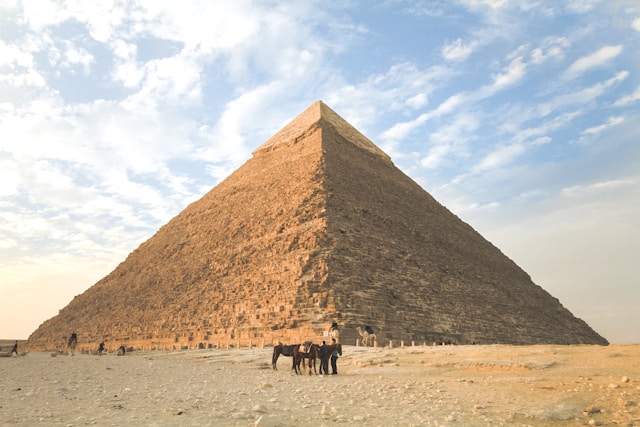The rich spirituality, rituals, and hieroglyphic writings of ancient Egypt are revealed when touring the Giza pyramids, but mysteries remain within the structures.
The Great Pyramid of Giza and other ancient Egyptian pyramids have long been mysterious buildings that have captivated people all over the world with their commanding presence in the middle of a desert.
Built in the era of the Old Kingdom in ancient Egypt, these architectural wonders continue to awe and intrigue scholars.
Discovering the numerous tunnels, chambers, and persistent mysteries that have captivated archaeologists and enthusiasts for centuries is revealed as we take a journey inside the center of these enormous constructions.
The reason behind the pyramids
Scholars generally agree that the pyramids served as colossal graves for pharaohs and other prominent people, despite the fact that their exact function has long been disputed.
The Great Pyramid of Giza is thought to be Pharaoh Khufu’s ultimate resting place.
The Great Pyramid of Giza is thought to be Pharaoh Khufu’s ultimate resting place.
The intricate network of passages and burial chambers inside the pyramid was intended to protect the pharaoh’s possessions and body during his ascension to the afterlife—a notion that was central to the religious beliefs of the ancient Egyptians.
The trio of rooms
The main focus of our investigation is the Great Pyramid of Giza, which was built for the pharaoh Khufu.
The carefully planned interior provides hints about the burial customs and religious beliefs of the ancient Egyptians. The King’s Chamber, the Queen’s Chamber, and a subterranean chamber make up the pyramid’s three principal chambers.
A red granite sarcophagus is kept within the imposing granite walls of the King’s Chamber. This chamber is not home to the remains of a pharaoh, despite its name.
Rather, it is thought to represent the pharaoh’s ascension to the afterlife, as described in the Pyramid Texts, the prehistoric religious texts that line the corridors and chamber walls.
With its connection to shafts running through the pyramid’s body, the Queen’s Chamber begs interesting questions regarding its intended use. Scholars continue to disagree over the purpose of these shafts, which lends the pyramid’s elaborate architecture an aura of mystery.
The Texts of the Pyramids
One of the earliest religious writings that humans are aware of is found in the Pyramid Texts, which are engraved on the walls of the ancient Egyptian pyramids. These Old Kingdom holy hieroglyphic inscriptions offer an intriguing window into the esoteric practices and beliefs of the ancient Egyptians.
Mostly discovered in the Fifth and Sixth Dynasty pharaohs’ pyramids, such those at Saqqara and Giza, the Pyramid Texts are an assemblage of religious instructions, songs, and spells.
A collection of religious instructions, songs, and spells is known as the Pyramid Texts.
They guarantee a smooth and secure passage for the pharaoh into the divine realm by acting as a guide for him during his journey through the afterlife.
The inscriptions present a sophisticated cosmology that describes the relationships between the deceased pharaoh and several gods, highlighting the pyramid’s significance as a sacred building closely associated with the ruler’s everlasting fate.
The emptiness
The study of these historic marvels has taken on new dimensions thanks to recent technological developments.
Cosmic-ray imaging was employed by the ScanPyramids project in 2017 to identify a sizable hollow inside the Great Pyramid.
Though it provides a tantalizing glimpse into the possibilities of hidden chambers or unexplored sections of the pyramid’s architecture, its nature and purpose are yet unknown.
Challenges with preservation
The pyramids’ preservation for next generations is a constant struggle. These historic buildings are at danger from things like air pollution, tourism, and aging naturally.
To lessen the effects of these variables, conservation activities are being carried out, striking a careful balance between preserving accessibility for tourists and guaranteeing the long-term preservation of these historical monuments.
The Egyptian pyramids are enduring symbols of human brilliance, engineering feats, and the mysteries of past civilizations.
These historic buildings are at danger from things like air pollution, tourism, and aging naturally.
The pyramids serve as a constant reminder of the rich historical and cultural legacy that have influenced our perception of the past, even as we work to uncover the mysteries hidden within their massive constructions.
These architectural marvels will continue to astonish and pique the curiosity of future generations thanks to continued investigation and preservation efforts, which also encourage us to consider the mystery that lies in the center of the Egyptian desert.




